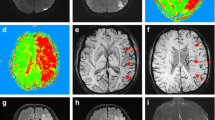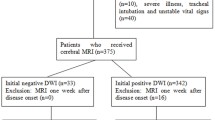Abstract
Purpose
The aim of this study was to investigate the clinical-radiological determinants of diffusion-weighted image (DWI) abnormalities in patients with suspected acute ischemic stroke (AIS) seen at the emergency room (ER).
Methods
During the study period, 882 consecutive patients were screened at Clínica Alemana de Santiago, Chile; 786 had AIS and 711 (90.4%) were included.
Results
DWI demonstrated 87.3% sensitivity and 99.0% specificity, with a positive likelihood ratio of 79 and a negative likelihood ratio of 0.13 for the detection of AIS. In the univariate analysis, a positive DWI in AIS was associated with admission National Institute of Health Stroke Scale (NIHSS) score (OR 1.09, 95% CI 1.04–1.1%), time from symptom onset to DWI (OR 1.03, 95% CI 1.01–1.05), presence of a relevant intracranial artery occlusion (OR 3.18, 95% CI 1.75–5.76), posterior circulation ischemia (OR 0.44, 95% CI 0.28–0.7), brainstem location of the AIS (OR 0.16, 95% CI 0.093–0.27), infratentorial location of AIS (OR 0.44, 95% CI 0.28–0.70), and lacunar (OR 0.27, 95% CI 0.11–0.68) or undetermined stroke etiology (OR 0.12, 95% CI 0.3–0.31). In multivariate analysis, only admission NIHSS score (OR 1.07, 95% CI 1.01–1.13), time from symptom onset to DWI (OR 1.04, 95% CI 1.01–1.13), brainstem location (OR 0.13, 95% CI 0.051–0.37), and lacunar (OR: 0.4, 95% CI 0.21–0.78) or undetermined etiology (OR: 0.4, 95% CI 0.22–0.78) remained independently associated.
Conclusion
DWI detects AIS accurately; the positivity of these evaluations in the ER is associated only with NIHSS on admission, time to DWI, brainstem location, and AIS etiology.
Similar content being viewed by others
References
Brunser AM, Hoppe A, Illanes S, Díaz V, Muñoz P, Cárcamo D et al (2013) Accuracy of diffusion-weighted imaging in the diagnosis of stroke in patients with suspected cerebral infarct. Stroke 44:1169–1171
Edlow BL, Hurwitz S, Edlow JA (2017) Diagnosis of DWI-negative acute ischemic stroke: a meta-analysis. Neurology 89(3):256–262
Chalela JA, Kidwell CS, Nentwich LM, Luby M, Butman JA, Demchuk AM, Hill MD, Patronas N, Latour L, Warach S (2007) Magnetic resonance imaging and computed tomography in emergency assessment of patients with suspected acute stroke: a prospective comparison. Lancet 369:293–298
Lovblad KO, Laubach HJ, Baird AE, Curtin F, Schlaug G, Edelman RR et al (1998) Clinical experience with diffusion-weighted MR in patients with acute stroke. AJNR Am J Neuroradiol 19:1061–1066
Oppenheim C, Stanescu R, Dormont D, Crozier S, Marro B, Samson Y, Rancurel G, Marsault C (2000) False-negative diffusion-weighted MR findings in acute ischemic stroke. AJNR Am J Neuroradiol 21:1434–1440
Singer MB, Chong J, Lu D, Schonewille WJ, Tuhrim S, Atlas SW (1998) Diffusion-weighted MRI in acute subcortical infarction. Stroke 29(1):133–136 Erratum in: Stroke 1998 Mar;29:731
Zuo L, Zhang Y, Xu X, Li Y, Bao H, Hao J, Wang X, Li G (2015) A retrospective analysis of negative diffusion-weighted image results in patients with acute cerebral infarction. Sci Rep 5:8910
Sylaja PN, Coutts SB, Krol A, Hill MD, Demchuk AM, VISION Study Group (2008) When to expect negative diffusion-weighted images in stroke and transient ischemic attack. Stroke 39:1898–1900
Brunser AM, Lavados PM, Cárcamo DA, Hoppe A, Olavarría V, Diaz V, Rivas R (2010) Additional information given to a multimodal imaging stroke protocol by transcranial Doppler ultrasound in the emergency room: a prospective observational study. Cerebrovasc Dis 30:260–266
Adams HP Jr et al (1993) Classification of subtype of acute ischemic stroke. Definitions for use in a multicenter clinical trial. TOAST. Trial of Org 10172 in acute stroke treatment. Stroke 24(1):35–41
Fisher CM, Curry HB (1965) Pure motor hemiplegia of vascular origin. Arch Neurol 13:30–44
Fisher CM (1967) A lacunar stroke: the dysarthria-clumsy hand syndrome. Neurology 17:614–617
Fisher CM (1965) Pure sensory stroke involving face, arm, and leg. Neurology 15:76–80
Fisher CM, Cole M (1965) Homolateral ataxia and crural paresis: a vascular syndrome. J Neurol Neurosurg Psychiatry 28:48–55
Makin SD, Doubal FN, Dennis MS, Wardlaw JM (2015) Clinically confirmed stroke with negative diffusion-weighted imaging magnetic resonance imaging: longitudinal study of clinical outcomes, stroke recurrence, and systematic review. Stroke 46:3142–3148
Gonzalez RG (2012) Clinical MRI of acute ischemic stroke. J Magn Reson Imaging 36:259–271
Saber Tehrani AS, Kattah JC, Mantokoudis G, Pula JH, Nair D, Blitz A, Ying S, Hanley DF, Zee DS, Newman-Toker DE (2014) Small strokes causing severe vertigo: frequency of false-negative MRIs and nonlacunar mechanisms. Neurology 83:169–173
Hart RG, Catanese L, Perera KS, Ntaios G, Connolly SJ (2017) Embolic stroke of undetermined source: a systematic review and clinical update. Stroke 48:867–872
Yaghi S, Herber C, Boehme AK, Andrews H, Willey JZ, Rostanski SK, Siket M, Jayaraman MV, McTaggart RA, Furie KL, Marshall RS, Lazar RM, Boden-Albala B (2017) The association between diffusion MRI-defined infarct volume and NIHSS score in patients with minor acute stroke. J Neuroimaging 27:388–391
Felfeli P, Wenz H, Al-Zghloul M, Groden C, Förster A (2017) Combination of standard axial and thin-section coronal diffusion-weighted imaging facilitates the diagnosis of brainstem infarction. Brain Behav 7:e00666
Yaghi S, Herber C, Willey JZ, Andrews HF, Boehme AK, Marshall RS, Lazar RM, Boden-Albala B (2015) Itemized NIHSS subsets predict positive MRI strokes in patients with mild deficits. J Neurol Sci 358:221–225
Freeman JW, Luby M, Merino JG, Latour LL, Auh S, Song SS, Magadan A, Lynch JK, Warach S, Hsia AW (2013) Negative diffusion-weighted imaging after intravenous tissue-type plasminogen activator is rare and unlikely to indicate averted infarction. Stroke 44:1629–1634
Abbott AL, Silvestrini M, Topakian R, Golledge J, Brunser AM, de Borst GJ, Harbaugh RE, Doubal FN, Rundek T, Thapar A, Davies AH, Kam A, Wardlaw JM (2017) Optimizing the definitions of stroke, transient ischemic attack, and infarction for research and application in clinical practice. Front Neurol 8:537
Author information
Authors and Affiliations
Corresponding author
Ethics declarations
Funding
No funding was received for this study.
Conflict of interest
The authors declare that they have no conflict of interest.
Ethical approval
All procedures performed in the studies involving human participants were in accordance with the ethical standards of the institutional and/or national research committee and with the 1964 Helsinki Declaration and its later amendments or comparable ethical standards.
Informed consent
Informed consent was obtained from all individual participants included in the study.
Rights and permissions
About this article
Cite this article
Brunser, A.M., Cavada, G., Venturelli, P.M. et al. Diffusion-weighted imaging determinants for acute ischemic stroke diagnosis in the emergency room. Neuroradiology 60, 687–692 (2018). https://doi.org/10.1007/s00234-018-2029-x
Received:
Accepted:
Published:
Issue Date:
DOI: https://doi.org/10.1007/s00234-018-2029-x




